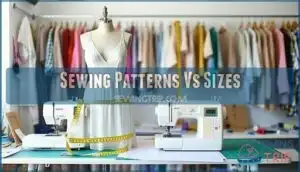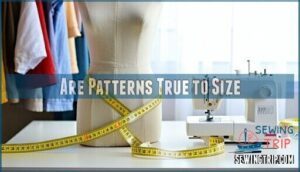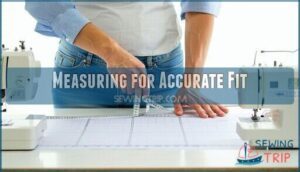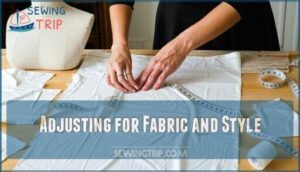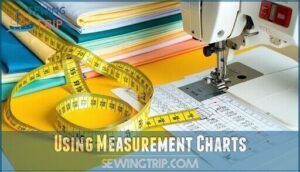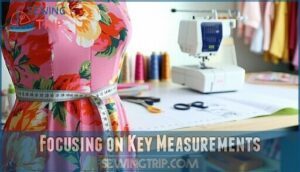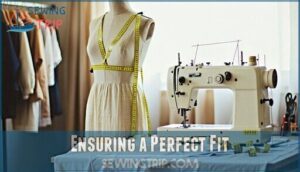This site is supported by our readers. We may earn a commission, at no cost to you, if you purchase through links.
 Sewing patterns aren’t true to size like your favorite jeans. They follow vintage sizing standards that run 2-4 sizes smaller than modern retail clothing.
Sewing patterns aren’t true to size like your favorite jeans. They follow vintage sizing standards that run 2-4 sizes smaller than modern retail clothing.
You can’t just grab your usual size 10 and expect magic. Instead, you’ll need to measure your bust, waist, and hips, then compare those numbers to the pattern’s measurement chart.
Think of it as your body’s blueprint rather than a guessing game. Each pattern company uses different sizing systems, so a size 12 from one brand might equal a size 14 from another.
The secret lies in understanding ease allowances and making smart adjustments based on your measurements.
Table Of Contents
Key Takeaways
- You can’t rely on your clothing size when buying sewing patterns – they follow vintage sizing standards from the 1950s that run 2-4 sizes smaller than modern retail clothing.
- You’ll need to measure your bust, waist, and hips accurately and compare those numbers to each pattern’s specific size chart, since every brand uses different measurements for the same size number.
- You should focus on your actual body measurements rather than the size label – a size 12 in your closet might require a size 16 or 18 pattern depending on your measurements.
- You’ll get better results by understanding ease allowances (extra room built into patterns) and blending between sizes when your measurements don’t align perfectly with one pattern size.
Sewing Patterns Vs Sizes
You’ll find that sewing patterns don’t match ready-to-wear clothing sizes because pattern companies use different measurement standards than retail brands.
While you might wear a size 12 in stores, your pattern size could be 16 or 18 based on your actual body measurements.
Variations in Body Shapes
Every body tells a different story through its unique proportions.
Every garment whispers secrets about the body it embraces, revealing stories through every seam and curve.
Body Shape Diversity creates Fit Challenges that make sewing pattern fit tricky.
Your shoulders might need a size 12 while your hips demand a 16.
Individual Body Types don’t follow standard charts, requiring Adapting Patterns for success.
Understanding these variations helps you master body measurements sewing.
| Body Area | Common Variations | Pattern Impact |
|---|---|---|
| Bust | Full, shallow, wide-set | Cup adjustments needed |
| Waist | High, low, undefined | Length modifications required |
| Hips | Narrow, wide, full thighs | Grade between sizes |
| Shoulders | Broad, narrow, sloped | Width alterations necessary |
| Torso | Long, short, curved | Back length adjustments |
Lack of Standardized Sizing
Nobody can agree on what size means anything. Each sewing pattern brand creates its own measurements, making pattern sizing accuracy a guessing game.
Historical sizing attempts failed because 90% of people wouldn’t fit standardized charts. Brand discrepancies force you into constant alterations, while RTW differences compound the confusion.
| Pattern Brand | Size 12 Bust | Size 12 Waist | Size 12 Hip | Sizing Notes |
|---|---|---|---|---|
| Butterick | 34" | 26.5" | 36" | Traditional ease included |
| Vogue | 34" | 26.5" | 36" | Matches Butterick standards |
| Burda | 36" | 28" | 38" | European sizing runs larger |
| Indie Patterns | 35" | 27" | 37" | Varies by designer preference |
| Vintage 1950s | 32" | 24" | 34" | Shows size inflation over time |
The table highlights the discrepancies between different pattern brands, with Butterick and Vogue having identical measurements for a Size 12, while Burda and Indie Patterns have slightly larger measurements, and Vintage 1950s patterns have significantly smaller measurements, demonstrating the lack of standardization in the industry.
Differences in Ready-to-Wear Sizes
Ready-to-wear clothing creates sizing chaos through brand inconsistencies and vanity sizing.
You’ll wear different sizes across manufacturers because each company uses unique fit models and targets specific demographics.
Size evolution means today’s medium equals yesterday’s large.
Unlike sewing pattern sizes, ready-to-wear measurements shift constantly, making your closet a mixed bag of numerical confusion.
To facilitate accurate pattern creation, it’s important to understand sewing pattern making measurements.
| Brand Type | Size 10 Bust | Size 10 Waist | Size 10 Hip |
|---|---|---|---|
| Designer | 34" | 26" | 36" |
| Mass Market | 36" | 28" | 38" |
| Plus-Friendly | 38" | 30" | 40" |
Are Patterns True to Size
Pattern sizes aren’t exactly true to size compared to your closet favorites. Understanding pattern sizes requires a different mindset than shopping for ready-to-wear clothing. Sewing pattern sizes follow older sizing standards from the 1950s, while clothing brands have shifted their numbers downward over time.
Here’s what makes pattern sizing unique:
- Pattern Grading creates consistent proportions across all sizes, unlike retail clothing
- Vintage Patterns maintain historical sizing standards that differ substantially from modern expectations
- Digital Patterns often include detailed size charts to help bridge this gap
Sizing Inconsistencies between pattern companies exist, but they’re more predictable than retail variations. Body Positivity in sewing means embracing your actual measurements rather than desired clothing tags. Pattern sizing issues stem from unrealistic expectations about numbers.
Focus on your measurements, not the size label, for better sewing success. Many resources offer free plus-size patterns for creative exploration.
Taking Body Measurements
You’ll need accurate body measurements to select the correct pattern size and achieve a proper fit.
Take these measurements while wearing your usual undergarments, holding the tape measure snug but not tight around your chest, waist, and hips, to ensure a proper fit.
Measuring for Accurate Fit
Getting accurate body measurements requires the right approach and measurement tools.
Precision in measuring equals perfection in sewing—your tape measure is your best friend.
Stand naturally with good posture importance while someone helps with hard-to-reach spots.
Consistent measuring means keeping your tape parallel to the floor and snug but not tight.
Use body landmarks like your natural waist for reference points.
For best results, use a non-stretch measuring tape for accuracy.
Take fresh measurements regularly since bodies change, ensuring your sewing pattern sizes match perfectly.
Key Measurement Points
Five essential body measurements determine your pattern size accurately.
Measure your high bust above the fullest part, then take your Accurate Bust Measurement at the fullest point.
Find your Waist Definition at the narrowest torso section.
Hip Placement occurs at your fullest hip area.
Record your Torso Length from neck to waist.
A vital tool is flexible measuring tape for accuracy.
Undergarment Impact affects all measurements, so wear your usual foundation garments to ensure Accurate Bust Measurement and consider the flexible measuring tape for best results.
Adjusting for Fabric and Style
Fabric types dramatically affect how patterns fit your body.
Knits stretch while wovens don’t, changing your ease preferences completely.
A fitted dress in cotton needs different pattern adjustments than the same style in jersey.
Consider fabric drape when selecting sizes – flowing materials hide fitting issues better than structured ones.
Your personal style also influences pattern ease allowance decisions for ideal sewing patterns fit.
Choosing The Right Pattern Size
Once you’ve taken your measurements, you’ll need to match them to the pattern’s size chart rather than your ready-to-wear clothing size.
Focus on your bust, waist, and hip measurements to find the closest match, keeping in mind that you may need to blend between sizes for the best fit.
Using Measurement Charts
Once you’ve captured your body measurements, you’ll need to interpret pattern size charts correctly.
Each pattern brand maintains its own sizing standards, so brand variations affect chart accuracy. Compare your measurements directly to the pattern size chart rather than assuming your ready-to-wear size applies.
This measurement consistency approach guarantees better fit prediction and proper size interpretation across different sewing size guides. You can find various sewing chart products online to help with size interpretation and ensure a better fit.
Focusing on Key Measurements
Once you’ve got your measurement charts sorted, you’ll need to zero in on what really counts.
Not every measurement carries equal weight when selecting your pattern size. Here’s what deserves your attention:
- Accurate Bust Measurement – Your high bust and full bust measurements determine upper body fit
- Waist-Hip Ratio – These measurements work together for lower body garments
- Torso Length Matters – Back waist length affects how garments hang on your frame
- Height Impact Fit – Your overall height influences sleeve and hem lengths
- Consistent Measurement Practices – Take measurements the same way each time for reliable results
These key measurements are crucial for ensuring a good fit, and understanding their importance will help you make the most of your pattern selection.
Adjusting for Garment Style
Different garment styles demand different sizing approaches.
A fitted blazer requires precise bust measurements, while a flowing maxi dress focuses on hip measurements.
Consider fabric drape when selecting sizes—knits stretch while wovens don’t.
Your silhouette choice affects fit priorities.
Design elements like gathers or pleats change how pattern ease allowance works, making adjustments essential for proper garment fit.
| Garment Type | Primary Measurement | Secondary Focus | Ease Consideration | Alteration Priority |
|---|---|---|---|---|
| Fitted Blouse | Bust/High Bust | Waist | Minimal ease | Bust adjustments |
| A-Line Skirt | Hip | Waist | Moderate ease | Waist grading |
| Straight Dress | Bust & Hip | Waist | Standard ease | Length & width |
| Flowing Top | Bust | Shoulder | Extra ease | Shoulder fit |
| Custom Jacket | Bust/Chest | Back width | Structured ease | Multiple points |
Ensuring a Perfect Fit
Understanding ease allowance helps you achieve the exact fit you want in your finished garment.
You’ll need to blend different pattern sizes to match your unique body measurements and create a custom fit that works perfectly for your shape, which involves understanding and applying ease allowance correctly.
Understanding Ease Allowance
Understanding ease allowance transforms your sewing experience from frustrating guesswork into confident crafting.
This extra room beyond your body measurements guarantees comfort and proper garment function.
As detailed on a webpage about what is ease, it’s essential for movement and style.
- Fitting ease provides essential movement space – typically 2.5 inches at bust, 1 inch at waist
- Design ease creates the intended silhouette and style of your garment
- Measuring ease helps calculate total allowance by subtracting body measurements from finished garment dimensions
Blending Sizes for Custom Fit
Once you’ve mastered ease allowance, you’re ready for pattern blending magic.
Multi-size patterns let you grade between sizes smoothly.
Start with your bust measurement size at the shoulders, then gradually shift to your hip size.
For those seeking specialized tools, consider products for pattern blending.
This custom fit tailoring approach beats buying separate patterns.
Mark shift points with a ruler, connecting lines with gentle curves for professional sewing pattern fitting results.
Frequently Asked Questions (FAQs)
Are sewing patterns at ‘nan’ true to size?
Sewing patterns aren’t true to size, they’re not false either.
They’re designed differently than ready-to-wear clothing.
Always measure your body and compare those measurements to the pattern’s size chart instead, to ensure the best fit, as patterns are not false.
How to find the right sewing pattern size?
Measure your chest, bust, waist, and hips while wearing usual undergarments.
Compare these measurements to the pattern’s size chart, not your clothing size.
Choose the size where most measurements align best.
What is a multi-size pattern?
Like a versatile toolkit, multi-size patterns contain multiple sizes on one tissue sheet.
You’ll find overlapping cutting lines for different sizes, letting you blend between measurements or adjust specific areas for a custom fit, which can be seen as a way to achieve a custom fit.
How do I select my pattern size?
Compare your body measurements to the pattern’s size chart, not your clothing size.
Focus on bust, waist, and hip measurements.
Choose the size where most measurements align, then blend between sizes if needed.
Why do people prefer sewing their own clothes?
You’ll love creating perfectly fitted garments that match your style preferences. Custom sizing eliminates guesswork, while choosing fabrics and colors gives you creative control that ready-to-wear simply can’t match.
How do I measure a finished garment?
Think you’re eyeballing that garment like a pro?
Lay it flat, use a tape measure across the widest points of chest, waist, and hips.
Don’t forget sleeves and length measurements for accurate sizing.
Are pattern sizes standardized across brands?
No, pattern sizes aren’t standardized across brands.
Each company uses its own size chart, so you’ll find different measurements for the same size number between manufacturers like Butterick, Vogue, or indie designers.
How is ease accounted for in pattern sizes?
Like a cushion built into a chair, ease gives you breathing room in garments.
Pattern designers add extra inches to body measurements for movement and comfort.
You’ll find 2-4 inches built into most designs automatically.
What is the difference between pattern sizes and measurements?
Body measurements determine your actual size, while pattern sizes translate those measurements into standardized categories.
You’ll measure your bust, waist, and hips, then match them to the pattern’s size chart for proper fit.
Are there any online resources for finding the right pattern size?
You’ll find helpful sizing guides on pattern company websites like Butterick, Vogue, and McCall’s. Many sewing blogs also offer measurement tutorials and size comparison charts to help you choose correctly.
Conclusion
Like a master carpenter who measures twice and cuts once, successful sewers know that sewing patterns aren’t true to size in the traditional sense.
Your measurements are the foundation of every well-fitting garment. Take accurate body measurements, compare them to pattern charts, and understand ease allowances.
Remember, pattern sizes follow vintage standards, not modern retail sizing. With proper measuring techniques and size adjustments, you’ll create clothes that fit your unique body perfectly.
Trust your tape measure, not your clothing label, and you will be able to make clothes that fit well, as well-fitting garment is the ultimate goal.

